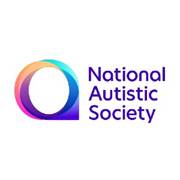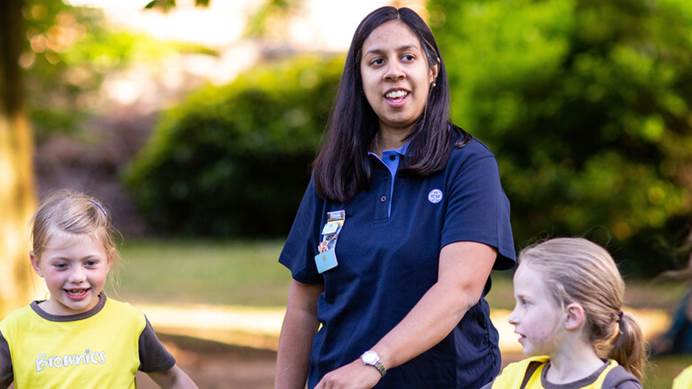Supporting autistic members
How to include autistic girls, young women and volunteers in guiding
We want autistic members to have a great guiding experience.
We want them to be able to pursue their passions and interests, to develop their potential and to experience positive friendships and relationships, in an inclusive environment that accepts and values difference.
We want you, as a volunteer, to feel confident and informed about autism, so you can welcome autistic members to your unit.
Understanding autism will help you to enable autistic members to get the most out of guiding. It’s important to remember that all autistic people are individuals. To make sure that autistic young people can take part in activities you’ll need to get to know each person as an individual, find out what will help them to feel happy and confident in your unit, and make any reasonable adjustments they might need; working them out together with their families or carers, where appropriate.
We've created this guidance with the National Autistic Society. It aims to describe the shared characteristics of autism, to give you some ideas for adjustments to consider for your unit and for things that you can do to create a space where autistic members can be themselves and have fun.

The National Autistic Society
Founded in 1962, the National Autistic Society is the UK’s leading charity for autistic people and their families. Their goal is to help transform lives, change attitudes and create a society that works for autistic people.
What is autism?
Autism is a lifelong developmental disability that affects how people perceive the world and interact with others.
Autistic people see, hear and feel the world differently to other people. If you are autistic, you are autistic for life; autism isn’t an illness or disease and cannot be 'cured'. Often people feel being autistic is a fundamental aspect of their identity.
Autism is a spectrum condition. All autistic people share certain difficulties, but being autistic will affect them in different ways. Some autistic people also have learning disabilities, mental health issues or other conditions, meaning people need different levels of support. All people on the autism spectrum learn and develop.
In order for a diagnosis to be made, a person will usually be assessed as having had ongoing difficulties with social communication and social interaction, restricted and repetitive patterns of behaviours, activities or interests and sensory differences, since early childhood; to the extent that these "limit and impair everyday functioning”.
You can learn more about these areas of difficulty and how you can help support them below.
Talking about autism
Over the years, different terms have been used for autism. Research from 2015 suggests that there is no single term that everyone prefers.
It’s important to check with the member and their family about the language that they use to talk about their diagnosis, and to take the lead from them. For example, some members may have been given a diagnosis of Asperger syndrome, and they prefer to use this term when talking about their diagnosis.
Confidentiality
Make sure you know whether the young person knows about their diagnosis, and whether they’re happy to talk about it. It’s also important to check how they feel about other people in the unit knowing about their diagnosis too: they may not want anyone else to know, or they may want to tell others about it. This all depends on the individual and their wishes must be respected.
Autistic girls and women
Some autistic girls and women mask their differences. They may copy behaviours from others around them in order to “blend in” and not seem different; this can be exhausting, as it takes constant thought, energy and effort to appear similar to other people. Sometimes people don’t realise that the autistic girl is ‘masking’ and working hard to join in.
This more subtle presentation of autism is also a major barrier to professionals recognising autism and understanding the experiences of autistic girls and women.
Autistic people can have difficulties with social interaction and communication skills, so forming relationships can be tricky, and sometimes takes a little longer. This can lead to feelings of isolation and loneliness, even when there are lots of people around.
Some autistic people may not speak or have limited use of speech, especially if they are feeling anxious or overloaded by their sensory experience. They can find understanding and using both verbal communication (eg speech) and non-verbal communication (body language, gestures, facial expression and tone of voice) difficult.
For instance, some autistic people prefer not to make eye contact, in order to focus on listening and understanding what is being said to them. Unfortunately, this can sometimes be misunderstood as not listening.
Many autistic people have a literal understanding of language, and think people always mean exactly what they say. For example, if a volunteer says “wait a minute”, an autistic young person might wait for precisely one minute, and then if they go over that time, think that the volunteer is not keeping to their word; this can be stressful for an autistic person.
Autistic people often have difficulty 'reading' other people – that is, recognising or understanding other people’s feelings and intentions, and have difficulty expressing their own emotions. This can make it very hard for an autistic person to navigate the social world. For instance, they may:
- appear to be insensitive, for example not looking like they care when someone else is upset.
- seek out time alone, away from other people.
- prefer to comfort themselves.
- appear to behave differently or in a way that others consider unusual or not appropriate for the situation.
- find it hard to form friendships.
- seem to only talk about their own likes and interests.
We can misunderstand autistic people’s responses and behaviour based on our own social experience and knowledge, but when we take the time to get to know each member as an individual, we have the privilege of learning more about the way they perceive and experience the world.
What you can do
- Develop a communication passport together.
- Give extra time for processing when interacting with each other – 6 seconds or more for turn taking can help.
- Many autistic people describe themselves as visual thinkers and often benefit from using visual communication strategies, such as drawing, writing and using pictures. This can be as simple as using some plain paper and coloured pens – share the paper and pens, in the same way we share conversations.
- Visual sequences and schedules can help a lot to explain activities and instructions. Try to use photographs or symbols where you can.
- Support and encourage members to make friends. Talk about how to approach members and together consider ways of starting a conversation with other people in the unit. Afterwards, take some time together to reflect on what worked well and what they might like to try next time. Celebrate the successes each time.
- Together, identify a member who seems kind and interesting to the autistic member to be their “buddy”. This will be a member committed to showing them the way things work when needed and who encourages them to join in an activity.
- Do your best to say what you mean, and use clear, consistent language.
- An autistic member may not realise that what they are doing appears to be unusual to some people. Sometimes they can be judged as rude, when most of the time that isn’t their intention. Understanding, supportive adults can help to develop good self-esteem. Discussion with parents/carers about how they support their young person in such instances, could facilitate a positive, consistent approach.
- A positive, empathic approach will also enable you to encourage an autistic young person in tricky situations and develop trusting relationships.
Find out more about supporting autistic people with social interaction.
Routines
The world can seem like a very unpredictable and confusing place to autistic people, who often prefer to have a routine so that they know what is going to happen every day. They may want to always travel the same way to and from school or unit meetings, or eat exactly the same food for breakfast.
The use of rules can also be important. It can be difficult for an autistic person to take a different approach to something once they have been taught the 'right' way to do it. People on the autism spectrum might not be comfortable with the idea of change, for example moving from one activity to another, or from one section to another. They may be able to cope better if they can prepare for changes in advance.
Repetitive behaviours
Repetitive behaviour may include arm or hand-flapping, finger-flicking, rocking, jumping, spinning or twirling, head-banging and complex body movements. You may also see the repetitive use of an object, such as flicking a rubber band or twirling a piece of string, or repetitive activities involving the senses (such as repeatedly feeling a particular texture). This is known as 'stimming' or self-stimulating behaviour.
Although repetitive behaviour varies from person to person, the reasons behind it may be the same, such as:
- An attempt to gain sensory input - eg rocking, may be a way to stimulate the balance (vestibular) system; hand-flapping may provide visual stimulation
- An attempt to reduce sensory input, eg focusing on one particular sound may reduce the impact of a loud, distressing environment; this may be seen particularly in social situations to deal with stress and anxiety, and to block out uncertainty
- To pass the time and provide enjoyment.
What you can do:
- Your unit meetings may already have a set structure. Try to make sure you follow the same format, as far as possible. Visual timetables will shortly be available to help you give autistic members a visual plan of unit meetings. Get in touch with us on [email protected] for more information.
- Give the member as much notice as possible, if there is a change for example, to the programme, venue or volunteers.
- If your unit is going somewhere new (for example, on a trip) help the member to prepare in advance. Work with parents/carers and the young person themselves, to decide how to do this. For example, looking at photos of where you are going, visit with a parent/carer before the trip. Consider together the extra support that might be needed for the trip, to help the member to manage the changes.
- If you’re planning an overnight trip, it’s especially important to work with parents/carers and the young person themselves to decide how to best support when needed. It might help to give them clear information about the timetable for the trip and the routine for each day. Check what food the young person enjoys, as many autistic people like to eat the same food each day.
- Find out if the member has bedtime routines that they need to follow, and if there are any familiar objects they’d like to bring from home to help them to feel comfortable and secure.
Many autistic people have difficulty processing everyday information. This can include sensory information too. Any or all of the senses (hearing, vision, touch, taste, smell, and balance, and body awareness) may be over- or under-sensitive (or even both) at different times. For example, certain background sounds, which other people ignore or can block out, can be unbearably loud or distracting for an autistic person. Being in crowded places or being knocked into may cause great anxiety or stress. Sometimes sensory sensitivities can even cause physical pain.
Sensory differences can affect a person’s communication skills and responses to situations and the environment; it can have a profound effect on a person’s life.
Sensory experiences are pleasurable and reassuring too, such as the feel of favourite fabric or the satisfaction of squeezing a squishy object. It’s important to find out the autistic member’s sensory preferences.
Autistic people might also seek out sensory stimulation, for example, they may be fascinated by lights or spinning objects. They may engage in ‘stimming’ such as flapping their hands, rocking, or jumping up and down – this can be a sign of excitement or sensory overload.
What you can do:
- Speak to the member and their parents/carers about what they know about their sensory experiences. Ask them what they might be sensitive to, giving examples of the senses to facilitate the discussion. Find out if there are sensory experiences they really like too. It can help to have some real objects, such as spinners, furry materials and colourful textured objects for the conversation.
- Think about the environment where your unit meets. Consider and discuss the potential sensory strengths and challenges, such as noise, light and temperature with the autistic member and their family. Solve problems Problem solve together as much as you can.
- Before going on trips and outdoor activities, go through the same process of considering the sensory environment and planning ahead.
- Consider together what could be done to ensure the member’s experience is not overwhelming. This may include having a favourite object with them or wearing noise cancelling headphones (if they use them already)
- Create a safe space and time between activities, to have “sensory breaks” away from over stimulation or other people (remember people are walking talking sensory stimuli). Check in after an agreed time alone, to encourage them to join their buddy if they feel ready to do so or to show that you care and you are nearby for them when needed.
- Consider quiet games and activities in the programme and invent new ones with autistic members that can be played with the whole unit.
Find out more about sensory difference for autistic people.
You might also want to find out more about the National Autistic Society's Too Much Information (TMI) Campaign.
Autistic people are often prone to stress and anxiety. This can mean that they become stressed or anxious in situations others don’t find difficult. Sometimes autistic people behave in unexpected ways when they’re stressed or anxious.
They may shout and get angry, retreat into themselves or try to run away. They might experience a meltdown - ‘an intense response to overwhelming situations’. This can happen when someone becomes completely overwhelmed by their current situation and temporarily loses control and the ability to cope.
What you can do:
- Find out what things make the member stressed or anxious, and how they react to those things.
- Know what the member needs you to do when they feel that way.
- If the member is prone to running away, make sure that you have carried out a risk assessment and have a plan with the autistic member and their parents/carers if they leave.
To learn more about how autistic young people experience stress and anxiety and how to support them, visit this advice on meltdowns and this advice on sports and activities.
Many autistic people have intense and highly-focused interests, often from quite a young age. These can change over time or remain lifelong interests. They can be anything from art or music, to trains or computers. An interest may sometimes be unusual. One autistic person might be exceedingly interested in collecting rubbish, for example. With encouragement, the person could develop an interest in recycling and the environment.
Many autistic people channel their interest into studying, paid work, volunteering, or other meaningful occupation. Autistic people often report that the pursuit of such interests is fundamental to their wellbeing and happiness.
Interests can be a great way to start conversations and form friendships within units.
Find out more
The National Autistic Society has a lot of information about autism on their website.



